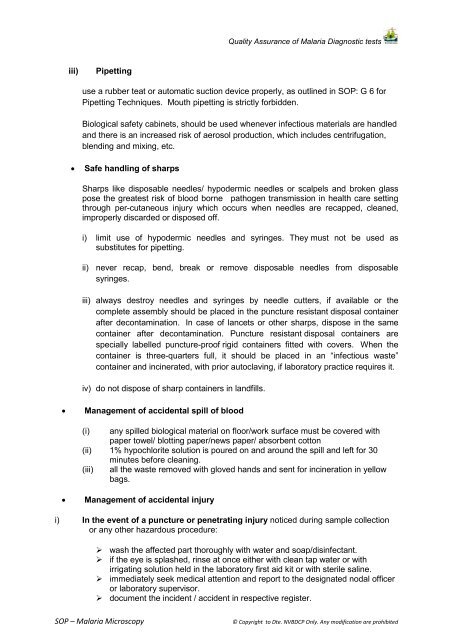SOP â Malaria Microscopy - NVBDCP
SOP â Malaria Microscopy - NVBDCP
SOP â Malaria Microscopy - NVBDCP
You also want an ePaper? Increase the reach of your titles
YUMPU automatically turns print PDFs into web optimized ePapers that Google loves.
Quality Assurance of <strong>Malaria</strong> Diagnostic testsiii)Pipettinguse a rubber teat or automatic suction device properly, as outlined in <strong>SOP</strong>: G 6 forPipetting Techniques. Mouth pipetting is strictly forbidden.Biological safety cabinets, should be used whenever infectious materials are handledand there is an increased risk of aerosol production, which includes centrifugation,blending and mixing, etc.• Safe handling of sharpsSharps like disposable needles/ hypodermic needles or scalpels and broken glasspose the greatest risk of blood borne pathogen transmission in health care settingthrough per-cutaneous injury which occurs when needles are recapped, cleaned,improperly discarded or disposed off.i) limit use of hypodermic needles and syringes. They must not be used assubstitutes for pipetting.ii) never recap, bend, break or remove disposable needles from disposablesyringes.iii) always destroy needles and syringes by needle cutters, if available or thecomplete assembly should be placed in the puncture resistant disposal containerafter decontamination. In case of lancets or other sharps, dispose in the samecontainer after decontamination. Puncture resistant disposal containers arespecially labelled puncture-proof rigid containers fitted with covers. When thecontainer is three-quarters full, it should be placed in an “infectious waste”container and incinerated, with prior autoclaving, if laboratory practice requires it.iv) do not dispose of sharp containers in landfills.• Management of accidental spill of blood(i) any spilled biological material on floor/work surface must be covered withpaper towel/ blotting paper/news paper/ absorbent cotton(ii) 1% hypochlorite solution is poured on and around the spill and left for 30minutes before cleaning.(iii) all the waste removed with gloved hands and sent for incineration in yellowbags.• Management of accidental injuryi) In the event of a puncture or penetrating injury noticed during sample collectionor any other hazardous procedure: wash the affected part thoroughly with water and soap/disinfectant. if the eye is splashed, rinse at once either with clean tap water or withirrigating solution held in the laboratory first aid kit or with sterile saline. immediately seek medical attention and report to the designated nodal officeror laboratory supervisor. document the incident / accident in respective register.<strong>SOP</strong> – <strong>Malaria</strong> <strong>Microscopy</strong>© Copyright to Dte. <strong>NVBDCP</strong> Only. Any modification are prohibited
















